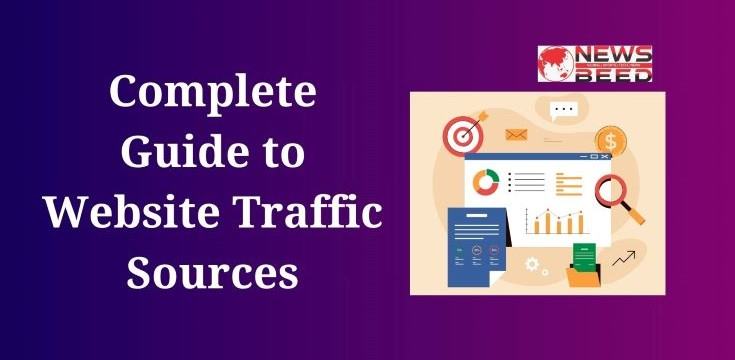In the dynamic landscape of the internet, website traffic is the lifeblood of online success. It represents the visitors who explore your site, engage with your content, and potentially convert into customers or clients. One crucial aspect of managing a website involves understanding and optimizing traffic sources. In this comprehensive guide, we’ll delve into the various traffic sources, providing a step-by-step exploration of each.
Table of Contents
ToggleI. Introduction to Website Traffic Sources
A. Definition
Website traffic sources refer to the origins of visitors to your site. These sources can be categorized into several types, each providing unique insights into user behavior.
B. Importance
Understanding traffic sources is essential for optimizing your website’s performance. By identifying where your visitors come from, you can tailor your content, marketing strategies, and user experience to meet their needs and preferences.
II. Types of Website Traffic Sources
A. Organic Traffic
1. Definition
Organic traffic comprises visitors who find your website through search engines like Google, Bing, or Yahoo. These users discover your site based on the relevance of your content to their search queries.
2. Optimization Strategies
- SEO (Search Engine Optimization): Implement on-page and off-page SEO techniques to improve your website’s visibility on search engine results pages (SERPs).
- Keyword Research: Identify and target relevant keywords to attract users searching for specific topics related to your content.
3. Tools
- Google Analytics: Monitor organic traffic, track keyword performance, and gain insights into user behavior.
- SEO Tools (e.g., SEMrush, Moz): Conduct keyword research, analyze backlinks, and track your website’s overall SEO health.
B. Direct Traffic
1. Definition
Direct traffic consists of visitors who type your website’s URL directly into their browser or use bookmarks to access your site. These users are already familiar with your brand.
2. Optimization Strategies
- Brand Building: Invest in brand awareness campaigns to encourage direct visits.
- User-Friendly URLs: Ensure that your website’s URL is easy to remember and share.
3. Tools
- Google Analytics: Track the volume of direct traffic and identify trends over time.
Also, Read This: What is Digital Marketing in Hindi
C. Referral Traffic
1. Definition
Referral traffic includes visitors who reach your site by clicking on a link from another website. This can be from social media, blogs, or other online platforms.
2. Optimization Strategies
- Link Building: Develop a robust link-building strategy to increase the number of quality backlinks to your site.
- Social Media Engagement: Actively participate in social media platforms to drive traffic from these channels.
3. Tools
- Google Analytics: Identify top referral sources and evaluate the performance of referral traffic.
D. Social Media Traffic
1. Definition
Social media traffic encompasses visitors who discover and engage with your content through various social media platforms such as Facebook, Twitter, Instagram, LinkedIn, and Pinterest.
2. Optimization Strategies
- Content Sharing: Create shareable content that resonates with your target audience.
- Consistent Posting: Maintain an active presence on social media by posting regularly.
3. Tools
- Social Media Analytics: Use platform-specific analytics tools to track engagement, clicks, and overall social media performance.
E. Paid Traffic
1. Definition
Paid traffic includes visitors who come to your site through paid advertising efforts, such as pay-per-click (PPC) campaigns on platforms like Google Ads or social media ads.
2. Optimization Strategies
- Ad Targeting: Define and target specific audience segments to maximize ad relevance.
- Ad Copy Optimization: Craft compelling ad copy to attract clicks and conversions.
3. Tools
- Ad Platforms: Utilize tools provided by advertising platforms to monitor and optimize your paid campaigns.
- Conversion Tracking Tools: Implement tools like Google Ads Conversion Tracking to measure the success of your paid campaigns.
F. Email Traffic
1. Definition
Email traffic comprises visitors who click on links within emails to access your website. This includes newsletters, promotional emails, and transactional emails.
2. Optimization Strategies
- Email Marketing Campaigns: Develop engaging email campaigns to encourage clicks.
- Personalization: Tailor email content based on user preferences and behavior.
3. Tools
- Email Marketing Platforms: Use platforms like Mailchimp, Constant Contact, or SendGrid to manage and analyze email campaigns.
- UTM Parameters: Incorporate UTM parameters in email links for detailed tracking in analytics tools.
III. Analyzing Website Traffic Sources
A. Google Analytics Setup
1. Installation
- Account Creation: Set up a Google Analytics account if you don’t have one.
- Property Creation: Create a new property for your website.
- Tracking Code Installation: Add the Google Analytics tracking code to your website.
2. Key Metrics
- Sessions: Measure the number of visits to your site.
- Users: Track the number of unique visitors.
- Bounce Rate: Assess the percentage of visitors who navigate away from your site after viewing only one page.
B. Identifying Traffic Sources
1. Overview Report
- Acquisition Overview: View the “Acquisition” section in Google Analytics to see an overview of your traffic sources.
2. Source/Medium Report
- Detailed Analysis: Access the “Source/Medium” report to dive deeper into specific traffic sources and mediums.
- Comparison: Compare performance metrics across different sources.
C. Conversion Tracking
1. Goals Setup
- Define Objectives: Set up specific goals, such as form submissions, product purchases, or page views.
- Conversion Funnel: Create a conversion funnel to track user journeys.
2. E-commerce Tracking
- Enable E-commerce Tracking: If applicable, enable e-commerce tracking to monitor transactional data.
- Product Performance: Analyze the performance of individual products.
IV. Optimization Strategies
A. Organic Traffic Optimization
1. Content Quality
- High-Quality Content: Produce valuable, informative, and engaging content.
- Regular Updates: Keep content updated to maintain relevance.
2. Technical SEO
- Site Speed: Optimize loading times for better user experience.
- Mobile Optimization: Ensure your site is mobile-friendly.
B. Referral Traffic Optimization
1. Relationship Building
- Build Partnerships: Collaborate with other websites and build relationships for mutual referrals.
- Guest Blogging: Contribute guest posts to relevant blogs in your industry.
2. Link Quality
- Quality Over Quantity: Prioritize high-quality backlinks over a high quantity of low-quality ones.
- Anchor Text Optimization: Use relevant anchor text for links.
C. Social Media Traffic Optimization
1. Platform Selection
- Target Audience: Identify the social media platforms where your target audience is most active.
- Content Tailoring: Customize content based on each platform’s unique characteristics.
2. Engagement Strategies
- Interactivity: Encourage comments, likes, and shares through interactive content.
- Hashtag Usage: Utilize relevant hashtags to increase discoverability.
D. Paid Traffic Optimization
1. Ad Testing
- A/B Testing: Test different ad variations to identify the most effective ones.
- Ad Copy Refinement: Continuously refine ad copy for better performance.
2. Budget Management
- ROI Analysis: Regularly analyze the return on investment to adjust your budget accordingly.
- Bid Management: Optimize bidding strategies for maximum efficiency.
E. Email Traffic Optimization
1. Segmentation
- Audience Segmentation: Segment your email list based on user behavior and preferences.
- Personalization: Tailor email content to each segment.
2. Automation
- Drip Campaigns: Set up automated drip campaigns to nurture leads over time.
- Behavioral Triggers: Implement triggers based on user actions.
V. Monitoring and Continuous Improvement
A. Regular Analytics Review
1. Periodic Checkups
- Monthly Reviews: Conduct monthly reviews of key analytics metrics.
- Identify Trends: Identify trends and patterns in user behavior.
B. Feedback Integration
1. User Feedback
- Surveys and Polls: Collect user feedback through surveys and polls.
- Customer Support Interactions: Pay attention to customer support interactions for valuable insights.
Also, Read This: Top 10 Most Popular Sports in India
C. Adaptation to Trends
1. Industry Trends
- Stay Informed: Stay updated on industry trends and adapt your strategies accordingly.
- Emerging Platforms: Explore new platforms and channels as they gain popularity.
Conclusion:
In conclusion, a comprehensive understanding of website traffic sources is paramount for achieving online success. By strategically optimizing each traffic channel and continually refining your approach based on analytics and user feedback, you can create a robust online presence that attracts and retains a diverse audience. Keep in mind that the digital landscape is ever-evolving, requiring a proactive and adaptive approach to stay ahead of the curve. Through diligent monitoring, thoughtful optimization, and a commitment to user satisfaction, you can build a thriving online presence that stands the test of time.




